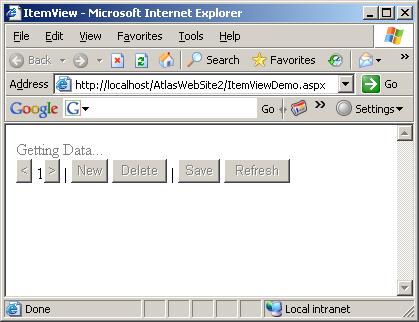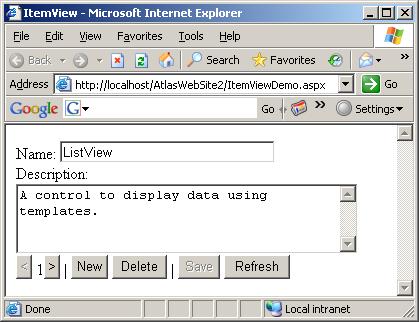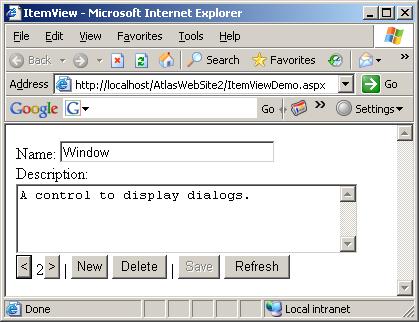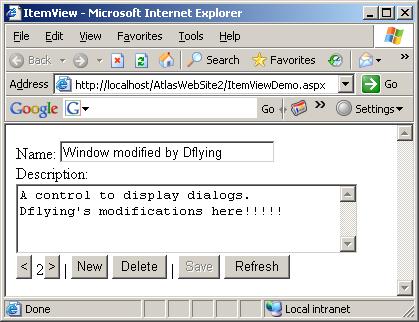English Version: http://dflying.dflying.net/1/archive/114_display_one_item_in_a_collection_using_aspnet_atlas_itemview_control.html
在这个系列中,我将介绍一些Atlas Sys.UI.Data中较高级的控件,包括:
- Sys.UI.Data.ListView:使用ASP.NET Atlas ListView控件显示列表数据
- Sys.UI.Data.ItemView:使用ASP.NET Atlas ItemView控件显示集合中的单个数据
- Sys.UI.Data.DataNavigator:使用 ASP.NET Atlas PageNavigator控件实现客户端分页导航
- Sys.UI.Data.SortBehavior:使用ASP.NET Atlas SortBehavior实现客户端排序
- Sys.UI.Data.XSLTView:使用ASP.NET Atlas XSLTView控件用XSLT修饰并显示XML数据
有时候我们需要显示给用户列表中某一项的详细信息,例如,在购物程序中的产品详细情况。ASP.NET Atlas ItemView客户端控件为您提供了对这项功能的支持,就像ASP.NET服务器端控件DetailsView一样,但Atlas ItemView控件完全在客户端运行。
ItemView类(ListView类同样,见使用ASP.NET Atlas ListView控件显示列表数据 )继承于Sys.UI.Data.DataControl基类。该基类提供了一些公共的属性,包括:
- canMoveNext:当前记录后是否有下一条记录。
- canMovePrevious:当前记录前是否有前一条记录。
- data:控件包含的数据集合。
- dataIndex:当前记录的index。
- dataItem:基于dataIndex的当前的记录。
- length:记录的条目数。
同时还包括下列方法:
- addItem:添加一条记录到当前的数据集合中。
- deleteCurrentItem:删除基于dataIndex的当前记录。
- moveNext:如果canMoveNext为true,将dataIndex加1,指向下一条记录。
- movePrevious:如果canMovePrevious为true,将dataIndex减1,指向前一条记录。
请注意所有的以上操作都仅在客户端,也就是说只修改了客户端的数据。所以如果您希望将改变提交到服务器,则需要调用 DataSource 的相应方法。
ItemView通过继承获得了以上的属性和方法,并且还对基类有如下扩展:
- itemTemplate:指定项目模版。Atlas可以根据这个模版渲染您的内容。
- emptyTemplate:指定无数据时的模版。当数据集合为空或者DataSource还在取得数据的过程中时,Atlas会显示这个模版。
以上是ItemView的简要介绍。让我们通过一个例子来熟悉ItemView。这个程序基于Atlas官方发布的示例程序,并适当做了一些简化。
首先暴露一个Web Service以被Atlas使用。
定义item entry类:
 public class Entry
public class Entry

 {
{ private string _name;
private string _name; private string _description;
private string _description; private int _id;
private int _id;
 [DataObjectField(true, true)]
[DataObjectField(true, true)] public int Id
public int Id

 {
{
 get
get  { return _id; }
{ return _id; }
 set
set  { _id = value; }
{ _id = value; } }
}
 [DataObjectField(false)]
[DataObjectField(false)] [DefaultValue("New row")]
[DefaultValue("New row")] public string Name
public string Name

 {
{
 get
get  { return _name; }
{ return _name; }
 set
set  { _name = value; }
{ _name = value; } }
}
 [DataObjectField(false)]
[DataObjectField(false)] [DefaultValue("")]
[DefaultValue("")] public string Description
public string Description

 {
{
 get
get  { return _description; }
{ return _description; }
 set
set  { _description = value; }
{ _description = value; } }
}
 public Entry()
public Entry()

 {
{ _id = -1;
_id = -1; }
}
 public Entry(int id, string name, string description)
public Entry(int id, string name, string description)

 {
{ _id = id;
_id = id; _name = name;
_name = name; _description = description;
_description = description; }
} }
}
定义 Web Methods 。我们需要提供 Select , Insert , Update 以及 Delete 方法以期对我们的数据集合进行完整的 CRUD 操作。注意到我们在初始化数据时使用了 System.Threading.Thread.Sleep(2000) 来模拟两秒钟的网络延迟,这样可以看到 emptyTemplate 中的内容。
 [WebService(Namespace = "http://tempuri.org/")]
[WebService(Namespace = "http://tempuri.org/")] [WebServiceBinding(ConformsTo = WsiProfiles.BasicProfile1_1)]
[WebServiceBinding(ConformsTo = WsiProfiles.BasicProfile1_1)] public class MyDataService : DataService
public class MyDataService : DataService

 {
{ static List<Entry> _data;
static List<Entry> _data; static int _nextId;
static int _nextId; static object _dataLock = new object();
static object _dataLock = new object();
 private static List<Entry> Data
private static List<Entry> Data

 {
{ get
get

 {
{ if (_data == null)
if (_data == null)

 {
{ lock (_dataLock)
lock (_dataLock)

 {
{ if (_data == null)
if (_data == null)

 {
{ System.Threading.Thread.Sleep(2000);
System.Threading.Thread.Sleep(2000);
 _data = new List<Entry>();
_data = new List<Entry>(); _data.Add(new Entry(0, "ListView", "A control to display data using templates."));
_data.Add(new Entry(0, "ListView", "A control to display data using templates.")); _data.Add(new Entry(1, "Window", "A control to display dialogs."));
_data.Add(new Entry(1, "Window", "A control to display dialogs.")); _data.Add(new Entry(2, "Weather", "A control to display local weather."));
_data.Add(new Entry(2, "Weather", "A control to display local weather.")); _nextId = 3;
_nextId = 3; }
} }
} }
} return _data;
return _data; }
} }
}
 [DataObjectMethod(DataObjectMethodType.Delete)]
[DataObjectMethod(DataObjectMethodType.Delete)] public void DeleteRow(int id)
public void DeleteRow(int id)

 {
{ foreach (Entry row in _data)
foreach (Entry row in _data)

 {
{ if (row.Id == id)
if (row.Id == id)

 {
{ lock (_dataLock)
lock (_dataLock)

 {
{ _data.Remove(row);
_data.Remove(row); }
} break;
break; }
} }
} }
}
 [DataObjectMethod(DataObjectMethodType.Select)]
[DataObjectMethod(DataObjectMethodType.Select)] public Entry[] SelectRows()
public Entry[] SelectRows()

 {
{ return MyDataService.Data.ToArray();
return MyDataService.Data.ToArray(); }
}
 [DataObjectMethod(DataObjectMethodType.Insert)]
[DataObjectMethod(DataObjectMethodType.Insert)] public Entry InsertRow(string name, string description)
public Entry InsertRow(string name, string description)

 {
{ Entry newRow;
Entry newRow; lock (_dataLock)
lock (_dataLock)

 {
{ newRow = new Entry(_nextId++, name, description);
newRow = new Entry(_nextId++, name, description); _data.Add(newRow);
_data.Add(newRow); }
} return newRow;
return newRow; }
}
 [DataObjectMethod(DataObjectMethodType.Update)]
[DataObjectMethod(DataObjectMethodType.Update)] public void UpdateRow(Entry updateRow)
public void UpdateRow(Entry updateRow)

 {
{ foreach (Entry row in _data)
foreach (Entry row in _data)

 {
{ if (row.Id == updateRow.Id)
if (row.Id == updateRow.Id)

 {
{ row.Name = updateRow.Name;
row.Name = updateRow.Name; row.Description = updateRow.Description;
row.Description = updateRow.Description; break;
break; }
} }
} }
} }
}
- Atlas服务器端控件ScriptManager。所有的Atlas页面中都需要包含这个控件以装载Atlas所必须的JavaScript文件。
- id为detailsView的<div>,将被Atlas用来输出渲染后的内容。
- 导航部分,用于在在客户端集合中导航,以显示集合中不同的记录。
- 命令部分,用于修改,添加,删除记录(在客户端),并且提交到服务器。
- 模版部分,用于指定相应的ItemView模版。所有的模版将被置于一个隐藏的div中,这样不会在页面上显示出来。
 <!--
ScriptManager
-->
<!--
ScriptManager
-->
 <
atlas:ScriptManager
runat
="server"
ID
="scriptManager"
/>
<
atlas:ScriptManager
runat
="server"
ID
="scriptManager"
/>

 <!--
Element for ItemView (container)
-->
<!--
Element for ItemView (container)
-->
 <
div
id
="detailsView"
>
<
div
id
="detailsView"
>
 </
div
>
</
div
>

 <!--
Navigators
-->
<!--
Navigators
-->
 <
input
type
="button"
id
="previousButton"
value
="<"
title
="Go to previous row"
/>
<
input
type
="button"
id
="previousButton"
value
="<"
title
="Go to previous row"
/>
 <
span
id
="rowIndexLabel"
></
span
>
<
span
id
="rowIndexLabel"
></
span
>
 <
input
id
="nextButton"
type
="button"
value
=">"
title
="Go to next row"
/>
<
input
id
="nextButton"
type
="button"
value
=">"
title
="Go to next row"
/>
 |
|
 <!--
Commands
-->
<!--
Commands
-->
 <
input
type
="button"
id
="addButton"
value
="New"
title
="Create a new row"
/>
<
input
type
="button"
id
="addButton"
value
="New"
title
="Create a new row"
/>
 <
input
type
="button"
id
="delButton"
value
="Delete"
title
="Delete the current row"
/>
<
input
type
="button"
id
="delButton"
value
="Delete"
title
="Delete the current row"
/>
 |
| <
input
type
="button"
id
="saveButton"
value
="Save"
title
="Save all pending changes"
/>
<
input
type
="button"
id
="saveButton"
value
="Save"
title
="Save all pending changes"
/>
 <
input
type
="button"
id
="refreshButton"
value
="Refresh"
title
="Discard pending changes and get the latest data from the server"
/>
<
input
type
="button"
id
="refreshButton"
value
="Refresh"
title
="Discard pending changes and get the latest data from the server"
/>

 <!--
Templates
-->
<!--
Templates
-->
 <
div
style
="visibility: hidden; display: none"
>
<
div
style
="visibility: hidden; display: none"
>
 <
div
id
="detailsTemplate"
>
<
div
id
="detailsTemplate"
>
 Name:
Name: <
input
id
="nameField"
size
="30"
/><
br
/>
<
input
id
="nameField"
size
="30"
/><
br
/>
 Description:
<
br
/>
Description:
<
br
/>
 <
textarea
id
="descriptionField"
rows
="4"
cols
="40"
></
textarea
><
br
/>
<
textarea
id
="descriptionField"
rows
="4"
cols
="40"
></
textarea
><
br
/>
 </
div
>
</
div
>
 <
div
id
="emptyTemplate"
>
<
div
id
="emptyTemplate"
>
 Getting Data
Getting Data
 </
div
>
</
div
>
 </
div
>
</
div
>
最后需要做的是在页面上添加Atlas脚本。
下面是DataSource的脚本:
 <
dataSource
id
="dataSource"
serviceURL
="MyDataService.asmx"
autoLoad
="true"
/>
<
dataSource
id
="dataSource"
serviceURL
="MyDataService.asmx"
autoLoad
="true"
/>
下面是 ItemView 的脚本。我们将绑定上面的 DataSource 控件作为数据源,并且将 ItemView 的 enabled 属性绑定到 DataSource 的 isReady 属性上,以期在数据源没有装载完成前禁用 ItemView 。同样为 ItemView 定义了 itemTemplate 和 emptyTemplate 。
 <
itemView
id
="detailsView"
>
<
itemView
id
="detailsView"
>
 <
bindings
>
<
bindings
>
 <
binding
dataContext
="dataSource"
dataPath
="data"
property
="data"
/>
<
binding
dataContext
="dataSource"
dataPath
="data"
property
="data"
/>
 <
binding
dataContext
="dataSource"
dataPath
="isReady"
property
="enabled"
/>
<
binding
dataContext
="dataSource"
dataPath
="isReady"
property
="enabled"
/>
 </
bindings
>
</
bindings
>
 <
itemTemplate
>
<
itemTemplate
>
 <
template
layoutElement
="detailsTemplate"
>
<
template
layoutElement
="detailsTemplate"
>
 <
textBox
id
="nameField"
>
<
textBox
id
="nameField"
>
 <
bindings
>
<
bindings
>
 <
binding
dataPath
="Name"
property
="text"
direction
="InOut"
/>
<
binding
dataPath
="Name"
property
="text"
direction
="InOut"
/>
 </
bindings
>
</
bindings
>
 </
textBox
>
</
textBox
>
 <
textBox
id
="descriptionField"
>
<
textBox
id
="descriptionField"
>
 <
bindings
>
<
bindings
>
 <
binding
dataPath
="Description"
property
="text"
direction
="InOut"
/>
<
binding
dataPath
="Description"
property
="text"
direction
="InOut"
/>
 </
bindings
>
</
bindings
>
 </
textBox
>
</
textBox
>
 </
template
>
</
template
>
 </
itemTemplate
>
</
itemTemplate
>
 <
emptyTemplate
>
<
emptyTemplate
>
 <
template
layoutElement
="emptyTemplate"
/>
<
template
layoutElement
="emptyTemplate"
/>
 </
emptyTemplate
>
</
emptyTemplate
>
 </
itemView
>
</
itemView
>
下面是导航部分的脚本。我们提供了一个label用来显示当前的记录编号(记录index加上1,使用了Atlas的Add transformer。关于Atlas transformer,您可以参考:在ASP.NET Atlas中创建自定义的Transformer )。还提供了前后移动记录的导航按钮(通过使用Atlas的InvokeMethod action调用相应的ItemView的方法)。
 <
button
id
="previousButton"
>
<
button
id
="previousButton"
>
 <
bindings
>
<
bindings
>
 <
binding
dataContext
="detailsView"
dataPath
="canMovePrevious"
property
="enabled"
/>
<
binding
dataContext
="detailsView"
dataPath
="canMovePrevious"
property
="enabled"
/>
 </
bindings
>
</
bindings
>
 <
click
>
<
click
>
 <
invokeMethod
target
="detailsView"
method
="movePrevious"
/>
<
invokeMethod
target
="detailsView"
method
="movePrevious"
/>
 </
click
>
</
click
>
 </
button
>
</
button
>

 <
label
id
="rowIndexLabel"
>
<
label
id
="rowIndexLabel"
>
 <
bindings
>
<
bindings
>
 <
binding
dataContext
="detailsView"
dataPath
="dataIndex"
property
="text"
transform
="Add"
/>
<
binding
dataContext
="detailsView"
dataPath
="dataIndex"
property
="text"
transform
="Add"
/>
 </
bindings
>
</
bindings
>
 </
label
>
</
label
>

 <
button
id
="nextButton"
>
<
button
id
="nextButton"
>
 <
bindings
>
<
bindings
>
 <
binding
dataContext
="detailsView"
dataPath
="canMoveNext"
property
="enabled"
/>
<
binding
dataContext
="detailsView"
dataPath
="canMoveNext"
property
="enabled"
/>
 </
bindings
>
</
bindings
>
 <
click
>
<
click
>
 <
invokeMethod
target
="detailsView"
method
="moveNext"
/>
<
invokeMethod
target
="detailsView"
method
="moveNext"
/>
 </
click
>
</
click
>
 </
button
>
</
button
>
下面是命令部分的脚本。这里我们能够在客户端添加/删除记录,并将改变提交给服务器或者放弃提交。
 <
button
id
="addButton"
>
<
button
id
="addButton"
>
 <
bindings
>
<
bindings
>
 <
binding
dataContext
="dataSource"
dataPath
="isReady"
property
="enabled"
/>
<
binding
dataContext
="dataSource"
dataPath
="isReady"
property
="enabled"
/>
 </
bindings
>
</
bindings
>
 <
click
>
<
click
>
 <
invokeMethod
target
="detailsView"
method
="addItem"
/>
<
invokeMethod
target
="detailsView"
method
="addItem"
/>
 </
click
>
</
click
>
 </
button
>
</
button
>

 <
button
id
="delButton"
>
<
button
id
="delButton"
>
 <
bindings
>
<
bindings
>
 <
binding
dataContext
="dataSource"
dataPath
="isReady"
property
="enabled"
/>
<
binding
dataContext
="dataSource"
dataPath
="isReady"
property
="enabled"
/>
 </
bindings
>
</
bindings
>
 <
click
>
<
click
>
 <
invokeMethod
target
="detailsView"
method
="deleteCurrentItem"
/>
<
invokeMethod
target
="detailsView"
method
="deleteCurrentItem"
/>
 </
click
>
</
click
>
 </
button
>
</
button
>

 <
button
id
="saveButton"
>
<
button
id
="saveButton"
>
 <
bindings
>
<
bindings
>
 <
binding
dataContext
="dataSource"
dataPath
="isDirtyAndReady"
property
="enabled"
/>
<
binding
dataContext
="dataSource"
dataPath
="isDirtyAndReady"
property
="enabled"
/>
 </
bindings
>
</
bindings
>
 <
click
>
<
click
>
 <
invokeMethod
target
="dataSource"
method
="save"
/>
<
invokeMethod
target
="dataSource"
method
="save"
/>
 </
click
>
</
click
>
 </
button
>
</
button
>

 <
button
id
="refreshButton"
>
<
button
id
="refreshButton"
>
 <
bindings
>
<
bindings
>
 <
binding
dataContext
="dataSource"
dataPath
="isReady"
property
="enabled"
/>
<
binding
dataContext
="dataSource"
dataPath
="isReady"
property
="enabled"
/>
 </
bindings
>
</
bindings
>
 <
click
>
<
click
>
 <
invokeMethod
target
="dataSource"
method
="load"
/>
<
invokeMethod
target
="dataSource"
method
="load"
/>
 </
click
>
</
click
>
 </
button
>
</
button
>
大功告成,可以在浏览器中测试了。
装载中:
装载完成:
记录间导航:
修改并保存:
上述示例代码可以在此处下载:http://files.cnblogs.com/dflying/AtlasItemViewDemo.zip






















 2488
2488











 被折叠的 条评论
为什么被折叠?
被折叠的 条评论
为什么被折叠?








